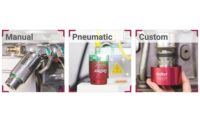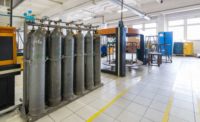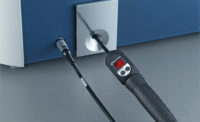Measurement equipment needs calibration. That goes without saying. But, when it comes to leak testing equipment, there are two issues to consider regarding regular calibration. One is the calibration of the leak orifice and the second is the calibration of the instrument to the test part and process.
The periodic calibration of the leak orifice is usually performed semiannually or annually, based on companies' ISO standards. This calibration should be performed on a regular basis to assure the accuracy of the leak standard.
However, equally, if not more importantly, the calibration of the instrument to the test part and process should be performed frequently during the day to correct for the changes in the test environment and the part that affect the pressure change measurement. These changes, called drift, can affect test accuracy. An optional process drift correction function within the instrument will automatically make corrections for the cyclical changes in the test conditions.
This correction of the calibration is important because some variations in parts and test environments cause little change to test results while other tests are greatly affected. Some companies are conscientious about periodic calibration and others only worry about it when high reject rates occur.
Using a process drift correction function maintains system accuracy throughout the production period, improves production throughput by eliminating production downtime for frequent recalibrations, minimizes the opportunity to incorrectly calibrate the system, and reduces false rejects and accepts.
Get the drift
Leak testing is a form of nondestructive testing that finds leak sites and measures the quantity of material passing through these sites. When testing a part with pressure and performing a pressure decay test, it is referred to as pressurizing the part. When testing a part with a vacuum and performing a vacuum decay test, it is referred to as evacuating the part.
To verify that a leak testing process is finding a specified hole or leak rate in a product, you must have a calibrated hole or leak that matches the specification. These leak orifices are not certified in terms of hole size but in terms of airflow rate at a specified pressure. A pressure decay or mass flow instrument measures the differences in the pressure change effect on a test part when the part has virtually no leak vs. a part with a leak that is marginally unacceptable as defined by the calibrated leak orifice.
Because a part has normal pressure change effects from being pressurized, the calibration process teaches the leak test instrument how much pressure change is a result of the normal testing process and how much additional change is due to a known, defined leak. With a known calibrated leak, the customer can add that leak to any portion of the direct test circuit and see if the instrument displays that leak rate at the conclusion of its test. Without a calibration process that measures the no-leak pressure change and defines the pressure change or flow change differential due to a traceable leak, there is no direct correlation of any testing process to the actual leak that the customer desires to find.
When a pressure decay or mass flow instrument is calibrated to a part and process, it has a pressure change or flow offset, known as the tar value, that represents a typical signal value measured by the instrument for a part that has no measurable leak. For every test, the instrument subtracts this offset value from the measured test signal and then calculates the corresponding leak rate.
The pressure change or flow offset value is a minute, residual, dynamically changing pressure or flow value caused by gradual temperature or volume changes in the sealed part. The pressure or flow change is measured during a precise time interval in the test procedure that is a dynamic process. Because leak tests are required in a short time cycle to meet production requirements, the test must be performed before the part's pressure completely stabilizes.
Normalization process occurs
The test procedure involves compressing air into a fixed volume. Depending on the test pressure, that compression process creates a level of heat in the compressed air called adiabatic heat effect. Because the temperatures of the air in the part itself and the air outside the part are not exactly the same, they all dynamically try to normalize to some new common temperature.
This normalization process happens in an exponential way. The pressure in the sealed part changes dynamically with the temperature because of the Ideal Gas Law, which is stated as PV = nRT. Likewise, if the part walls move because of being pressurized, the volume of the part changes exponentially as the part stops growing. The pressure again will change dynamically with the volume change because of the Ideal Gas Law. The instruments read the pressure changes at precise time intervals along these dynamically changing pressure curves. If any conditions of the test change, it will alter the shape of the dynamically changing curve.
For example, if a part is tested in a non-air-conditioned factory, the temperature of the air in that factory will change gradually during the day from 70 to 90 degrees and back to 70 degrees. The change in the plant air temperature causes a change in the temperature relationship of the air temperature in the part vs. the part temperature vs. air temperature outside the part. If the differences are greater, temperature change and therefore pressure change will occur at the precise time when pressure loss is measured. Therefore the tar value or pressure offset will not be the same as when the instrument was calibrated. This will cause an error in the calculated leak rate. Because a pressure change of 0.01 per square inch might represent the 10 standard cubic centimeters per minute leak rate, a variation of 0.0005 per square inch would represent a 5% drift in calculated leak rate. This could translate to a difference in temperature change during the test of only 0.001 F.
Temperature sensitive parts, such as heat exchangers, are greatly affected by temperature changes while heavily walled products or plastic products are not. Metal products are less susceptible to elasticity or volume changes than plastic products. For heat exchanger products, drift correction might prevent accepting 10% reject products or rejecting 10% accept products. For less temperature or volume-dependent products, process drift correction could affect the results of 1% to 2% of the products.
If the amount of drift in the leak rate results is unacceptable, the user has the option to recalibrate the instrument as frequently as necessary to track the unacceptable drift in test results.
Some leak test products have a function that tracks the drift and corrects the calculated leak rate. This function keeps the instrument's calibration tuned to the process that includes changes in fill-air temperature, part temperature, ambient temperature, part elasticity, part absorption and seal creep.
Before activating an automatic process drift correction, it is usually best to download a day's production test results and plot them to see just how much drift does occur. Some instruments can store up to 1,000 test results, and most leak test products can download results via a RS232 port. A time plot of the test results will show the cyclical effects of the process drift on the test results. Also, the magnitude of the drift can be evaluated to determine if it adversely affects the test results.
After analyzing the typical pressure change values over a typical production day and determining that most of the pressure loss changes occur in a cyclical fashion, process drift correction can be used to nearly eliminate performing automatic calibration to keep the instrument tuned to the process. A calibration verification will show that the system is accurately reading the leak rate.
TECH TIPS
- Temperature sensitive parts, such as heat exchangers, are greatly affected by temperature changes while heavily walled products or plastic products are not. Metal products are less susceptible to elasticity or volume changes than plastic products.
- The process drift correction function keeps the instrument's calibration tuned to the process which includes changes in fill-air temperature, part temperature, ambient temperature, part elasticity, part absorption and seal creep.
- Before activating an automatic process drift correction, it is usually best to download a day's production test results and plot them to see just how much drift does occur.
- Most leak test products can download results via a RS232 port.


